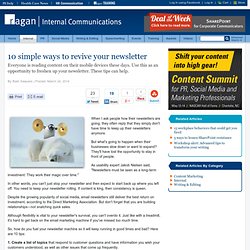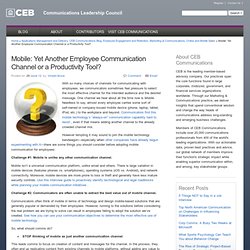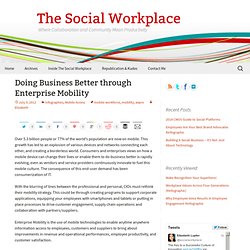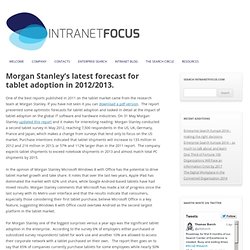

How Twitter, Facebook and Google+ Expand Marketing Reach. 10 simple ways to revive your newsletter. When I ask people how their newsletters are going, they often reply that they simply don't have time to keep up their newsletters anymore.

But what's going to happen when their businesses slow down or want to expand? They'll have lost the opportunity to stay in front of people. As usability expert Jakob Nielsen said, "Newsletters must be seen as a long-term investment: They work their magic over time. " In other words, you can't just stop your newsletter and then expect to start back up where you left off. You need to keep your newsletter rolling. Despite the growing popularity of social media, email newsletters still deliver the best return on investment, according to the Direct Marketing Association. Although flexibility is vital to your newsletter's survival, you can't overdo it. So, how do you fuel your newsletter machine so it will keep running in good times and bad?
2. 3. 4. [RELATED: Prepare your corporate communications for a content war! 5. 6. 7. 8. 9. 10. (Image via) How Mobile Enables Informal Learning. Informal learning is not a new concept.

However, the use of “informal learning” and video in the context of corporate development has emerged in the past five or so years. One of the best similes to describe informal learning is as follows: The Team – The rebirth of employee communication – Lean-back and move forward. Back to Team Talk The shift in reading and the ways we consume content will only accelerate.

We need to adapt our approach to reflect the changing media habits and behaviours of wider society; why should those behaviours and habits change from home to office? For many of us the summer months mean holidays, the joys of travelling and long journeys, a quieter commute to work, or simply longer sun-kissed evenings enjoying the delights of home and hearth. It’s also the time of year where the gift of more time allows the opportunity to read the latest blockbuster novel, catch-up on what’s new and innovative in management thinking or what’s hot or not in current affairs and politics.
The Mobile Employee. CEC Insider » Mobile Communications: Design for Goal, Not For Technology. CEC Insider » Mobile: Yet Another Employee Communication Channel or a Productivity Tool? With so many choices of channels for communicating with employees, we communicators sometimes feel pressure to select the most effective channel for the intended audience and the desired message.

One channel we hear about all the time now is Mobile. Needless to say, almost every employee carries some sort of self-owned or company-issued mobile device (phone, laptop, tablet, iPod, etc.) to the workplace and beyond. Communicators find this mobile technology’s “always-on” communication capability hard to resist , even if that means adding another channel to the already crowded channel mix. However tempting it may sound to join the mobile technology bandwagon—especially when other companies have already begun experimenting with it—there are some things you should consider before adopting mobile communication for employees: Challenge #1: Mobile is unlike any other communication channel. Mobile isn’t a universal communication platform, unlike email and others. So, what should comms do? Doing Business Better through Enterprise Mobility. Over 5.3 billion people or 77% of the world’s population are now on mobile.

This growth has led to an explosion of various devices and networks connecting each other, and creating a borderless world. Consumers and enterprises views on how a mobile device can change their lives or enable them to do business better is rapidly evolving, even as vendors and service providers continuously innovate to fuel this mobile culture. The consequence of this end-user demand has been consumerization of IT. With the blurring of lines between the professional and personal, CIOs must rethink their mobility strategy. This could be through creating programs to support corporate applications, equipping your employees with smartphones and tablets or putting in place processes to drive customer engagement, supply chain operations and collaboration with partners/suppliers. In fact, enterprise mobility can have the following positive outcomes:
Intranet Focus » Morgan Stanley’s latest forecast for tablet adoption in 2012/2013. One of the best reports published in 2011 on the tablet market came from the research team at Morgan Stanley.

If you have not seen it you can download a pdf version. The report presented some optimistic forecasts for tablet adoption and looked in detail at the impact of tablet adoption on the global IT software and hardware industries. On 31 May Morgan Stanley updated this report and it makes for interesting reading. Morgan Stanley conducted a second tablet survey in May 2012, reaching 7,500 respondents in the US, UK, Germany, France and Japan, which makes a change from surveys that tend only to focus on the US market.
Purchase intentions indicated that tablet shipments will increase to 133 million in 2012 and 216 million in 2013, or 57% and 112% larger than in the 2011 report. In the opinion of Morgan Stanley Microsoft Windows 8 with Office has the potential to drive tablet market growth and take share. Martin White. How Are Smartphones Being Used? [Infographic] The Latest Infographics: Mobile Business Statistics For 2012. DEBATE: Will Mobile change the game for Internal Communication?